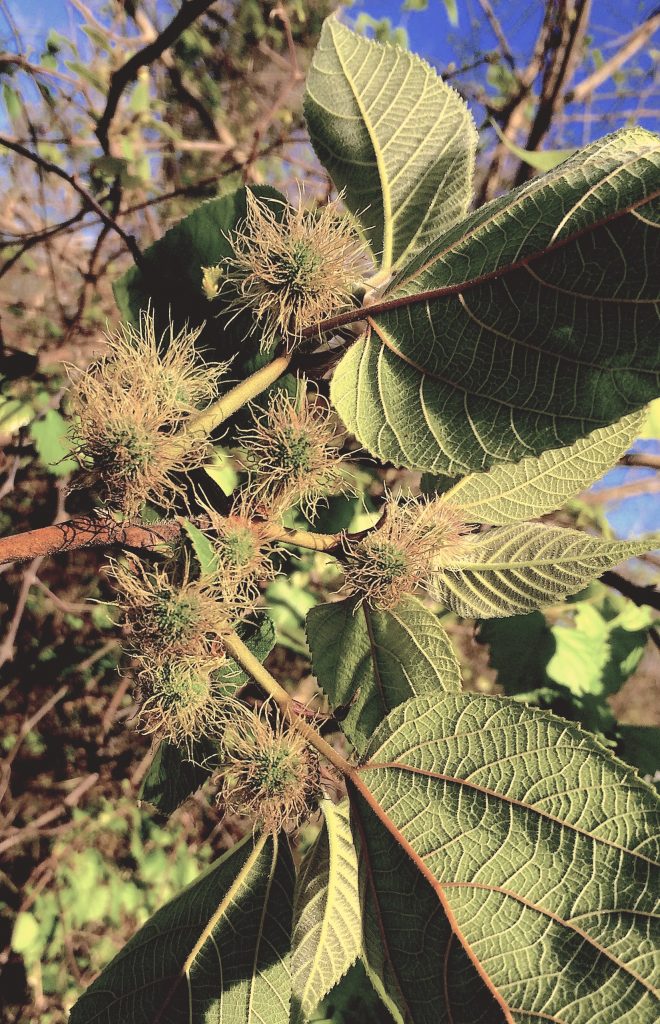
Is the unseasonal weather causing Paper Mulberries to fruit? The “hairs” turn fat, orange and sweet. Photo by Green Deane
At the seventh annual Florida Herbal Conference one of the teachers, Andy Firk, advocated walking as a means of plant discovery. He found many species while walking near where he lived. Even bicycling is too fast, Andy says. The day after the conference ended I had an opportunity to take Andy up on his advice. My motorcycle needed a front tire badly. It was cracking with age, much like me. A shop had ordered the tire for me so I gingerly rode to their garage. As the replacement would take a couple of hours, I decided to walk to a mall about a mile away.
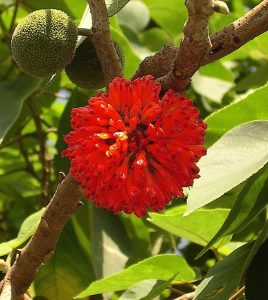
Paper Mulberry fruit when ripe.
There were the usual botanical suspects one finds walking this time of year although with qualifications. We had a couple of very cold weeks last month replaced by a warming trend followed by two weeks of record-hot weather for this time of year. While sauntering I saw something unusual, almost. Paper Mulberries are quite common locally. They are an escaped ornamental that botanists truly misjudged. They imported male colones — to control reproduction — but never considered the possibility of vegetative expansion which made them widespread. By the time others unthinkingly brought in some female Paper Mulberries there were more than enough guys for extensive botanical hanky pankey. One of the more interesting aspect of the Paper Mulberry is that it is a temperate forest tree. While it grows in Central Florida I have never seen it fruit here: Too warm in the winter, supposedly. One hundred miles to the north in Ocala it does have enough chill hours to fruit. But locally in over two decades of watching them nary a single fruit here … until now. While walking to the mall I noticed a Paper Mulberry putting on fruit. That’s the first time I’ve seen it here and also about six to eight weeks early compared to an April fruiting season in Ocala or Jacksonville. The cold snap and the heat wave seem to be likely reasons. One also should consider that the seasons are shifting their dates with several plants perhaps because of long-term climate effects. Ma Nature has a mind of her own. You can read about Paper Mulberries here.

Mayflowers: First blossoms of spring in Maine
Noticing any floral scents in the air this time of year? More than likely it is one of two sources. If you are driving along and notice a sweet aroma it is probably citrus in blossom. When I first moved to Florida, and had not gone thought a citrus blossoming season, I thought I was smelling Mayflowers, aka Trailing Arbutus. Usually blossoming after scentless Pussy Willows, Mayflowers were the first flower aromas of spring (and edible.) My mother and I would go hunting for them in rocky hills in Maine as soon as the ground was dry enough to walk on after the spring melt. And what of the second scent? If you are walking or bicycling now and go in and out of a sweet flower smell that is probably the deceptive Cherry Laurel, Prunus caroliniana. I call it deceptive because its blossoms smell nice and when you crush the leaves there is a distinct aroma of almonds (some say Maraschino Cherries.) Either way the tree, leaves and fruit is laced with cyanide (actually a chemical which on digestion produces fatal cyanide.) The tree and all its parts are to be totally avoided. Unlike most cherries it had a fruit with a hard point, NOT EDIBLE. Because it stays green all year (hence the term Laurel) and is a native the Cherry Laurel is used a lot in landscaping. Ingesting a small branch can kill a 600-pound steer in 20 minutes, you much quicker, a child even quicker. Leave it alone.
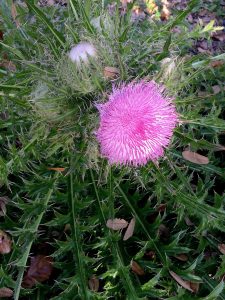
Bull Thistle Blossom. Photo by Green Deane
As every year before it the seventh Florida Herbal Conference was a success. Some 700 folks converged for the weekend about 15 miles east of Lake Wales to study herbalism and related topics. A dozen plus teachers taught three dozen classes ranging from Remembering Grandmother’s Tea to Reclaiming our Healing Roots. Linda and Luke Black Elk from the Standing Rock Reservation were featured speakers. I had two edible plants walks for adults and one for children. In past years the weather for the conference has been average to bone chilling cold. This year it was air-conditioner hot which perhaps influenced the plants we saw. There were the usual February forgeables such as Smilax, Peppergrass, Pellitory, Western Tansy Mustard, Oxalises, Dollarweed, Gotu Kola, Heartleaf Sorrel, and Horseweed. But there was also past-season still green as well as new blossoming Smartweed. A toxic Tropical Soda Apple was blossoming, months early. I suspect the unusual weather also produced a huge Bull Thistle, photo left. It’s a two-year plant in northern climes but locally can go through its two-stage cycle in succession without overwintering. It’s the bane of cow pastures and a staple of foragers. You can read about it here.
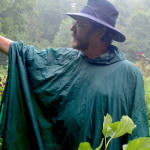
Foraging classes are held rain or shine or cold…
Foraging Classes: Please take note that a foraging class has been scheduled for March 10th at Haulover Canal. The bridge there has reopened allowing us to look at all four quadrants of that historic canal. This is always conditional in that the federal agency in charge can close the bridge at any time for any reason.
Sunday, March 4th, Eagle Park Lake, 1800 Keene Road, Largo, FL 33771. 9 a.m. Meet at the pavilion by the dog park.
Saturday, March 10th, Haulover Canal, Merritt Island National Refuge, north of the Kennedy Space Center. 9 a.m. If northbound go over the bridge, take next left, a dirt road, at the canal turn right, go to end. Park anywhere. If southbound a quarter of a mile before the bridge turn right onto dirt road, turn right at the canal, go to end. There is no drinking water, and the bathrooms are one Port-O-Let. It is hot, dry and dusty and we walk about three miles.
Sunday, March 11th, Bayshore Live Oak Park, Bayshore Drive, Port Charlotte. 9 a.m. Meet at the parking lot on Bayshore Drive across from Ganyard Street.
Saturday, March 17th, Blanchard Park, 10501 Jay Blanchard Trail, Orlando, FL 32817. 9 a.m. Meet at the Pavilion east of the tennis courts near the YMCA.
Sunday, March 18th, Dreher Park, 1200 Southern Blvd., West Palm Beach, 33405, 9 a.m. Meet just north of the Science Center in the northern half of the park.
Saturday, March 24th, Florida State College, south campus, 11901 Beach Blvd., Jacksonville, 32246. 9 a.m.We will meet at building “D” next to the administration parking lot.
To read more about the classes or to pre-pay go here.
Every forager has serious hang-ups so we might as well discuss them: Thorns, spines and prickles. Wintertime can present a foraging challenge to those who live in colder climates. I have written about that as I did grow up in Maine. You can read that article here. Wintertime, even in warmer areas, can also be a good time to look at some plants more closely than other times of the year. One example is the ability to see thorns, spines and prickles more clearly.
While their function can be similar this trio of sharpies have different characteristics and grow on different parts of the plant. This doesn’t mean much when one is in your thumb or starts your ankle bleeding but it can help you to understand some plants better. The main function of these sharp interruptions is to persuade those who eat greenery to dine elsewhere. But they can have secondary functions as well.
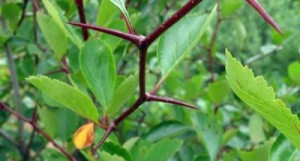
Thorns are always associated with a leaf.
Thorns are modified stems, often strong and formidable, and they are connected to the plant’s vascular system usually from deeply-seated tissue. They are almost always accompanied by a leaf. Think thorn-leaf. One genus that come to mind is the Hawthorn. Literally across the dirt road where I grew up there was a Hawthorn with two-inch thorns. It was a favorite nesting place for birds because the thorns kept most predatory or egg-stealing mammals at bay. I don’t know about snakes but in cold New England snakes weren’t a common problem. As modified stems (read branches) thorns can and often do have leaves. They can also branch. Other species with true thorns include Firethorn (Pyracantha) and Japanese flowering quince.
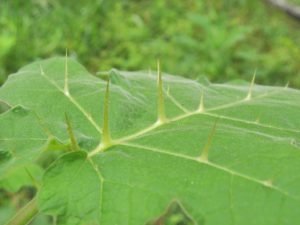
Some toxic Nightshades are well-armed with spines.
Unlike thorns spines are modified leaves or modified stipules which are leaves that really never got out of puberty. They are also attached to the plant’s vascular system, usually external tissue, and are located right below the leaf scar. Acacia and Locus are well-known for spines. Here in Florida the Water Locust is well-armed. Climbing the tree is simply out of the question. One species, Gleditsia triacanthos, can have spines more than a foot long. That’s protection. Do know that some botanists say the Locust have thorns not spines. Not all is settle science in Botanyland.
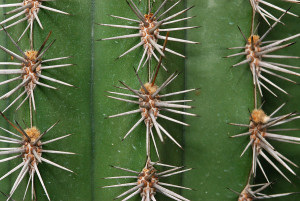
Cactus spines are actually leaves.
Cactus also have “spines” but they are quite distinct. In the cactus the spine is actually the leaf itself. What it is growing out of is actually a branch. So on a cactus the spines are actually leaves and the pad is actually a branch. Tiny spines are called “glochids” and are particularly irksome. Cactus spines can also be barbed so to work their way into an offended finger, paw or mouth. And while one does not often think of it spines also provide some shade for the plant. Don’t forget that common names can be wrong. The Euphorbia called “Crown of Thorns” should be called Crown of Spines.
If that was not confusing enough, some plants with spines have those modifications on stiff leaves. The American and English hollies are good examples as is the Oregon Grape Holly. Before modern brushes folks would tie English or American Holly branches into a bundle and drag the bundle up and down their chimneys to clean them. Two common species with spines on their leaf margins are Pineapples and Agaves.
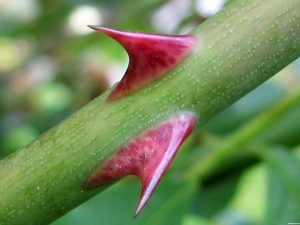
Roses have prickles, not thorns.
Many plants that are thought to have thorns or spines actually have prickles. It rather destroys the old saying that “every rose has a thorn.” Prickles are more along the line of plant hairs on steroids and can be found anywhere on the plant. Where thorns (stems) and spines (leaves) have definite locations prickles are here and there and arise from surface material thus they can break off easily, or more easily than thorns or some spines. Besides the rose the related shrubs Hercules Club and Prickly Ash have prickles. The latter is a tree that was actually named correctly. Perhaps the best armed tree in North America is the Silkfloss Tree. It is bristling with prickles up to two inches long.
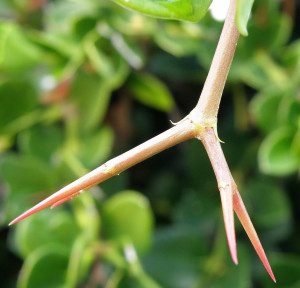
Natal Plums have double sets of thorns.
Prickles are often said to help a plant climb, as in a blackberry. And interestingly thorns are also said to help plants climb. Spines are not. As one might expect humans have been encountering these pointy problems for a long time but also using them. They have been employed as needles, pins, and fish hooks. Armed plants have also been used for protection against wild animals and protection for domestic animals and crops. Locally the Natal Plum, which produces an edible fruit, is often planted outside windows. Its double sets of thorns make burglars think twice. But I also would think twice about jumping out a window if I had to land on a Natal Plum. When kept short armed plants can be protective or one can grow them tall and cut off lower offending branches. Knowing the difference between thorns, spines and prickles won’t take the pain away but it can help make the plant identification easier.

EatTheWeeds Go Fund Me campaign
Donations to upgrade EatTheWeeds.com and fund a book are going well and is approaching the half way mark. Thank you to all who have contributed to either via the Go Fund Me link, the PayPal donation link or by writing to Green Deane POB 941793 Maitland FL, 32794. Recent upgrades have been paid now the Forum needs work and several function problems need to be fixed specifically the search and categories. One goal is to will the site to an organization that will maintain and expand it. A new server also has to be found by April in that the current server — Hostgator — does not provide larger enough capacity to back up the site as it is now. The other issue and not one expected is the difficulty of finding an indexing program or function of a real book. Writing programs used to do it automatically if you designated a term for indexing. Now that most books are ebooks most writing programs do not provide and indexing function. The hunt continues.

Green Deane Forum
Want to identify a plant? Looking for a foraging reference? Do you have a UFO, an Unidentified Flowering Object you want identified? On the Green Deane Forum we chat about foraging all year. And it’s not just about warm-weather plants or just North American flora. Many nations around the world share common weeds so there’s a lot to talk about. There’s also more than weeds. The reference section has information for foraging around the world. There are also articles on food preservation, and forgotten skills from making bows to fermenting food. One special section is “From the Frightening Mail Bag” where we learn from people who eat first then ask questions later. Recent topics include: Cleavers, Five-Petal Yellow Vine, That’s Poor Man’s Pepper, Coconut Purslane Salad, Green Leaves Inner Purple Outline, New Foraging Seasons, Plant’s In Obama’s Portrait, American Nightshade, and What Plant is this? You can join the forum by clicking on “forum” in the menu.

Green Deane DVD Set
All of Green Deane’s videos available for free on You Tube. They do have ads on them so every time you watch a Green Deane video I get a quarter of one cent. Four views, one cent. Not exactly a large money-maker but it helps pays for this newsletter. If you want to see the videos without ads and some in slightly better quality you can order the DVD set. It is nine DVDs with 15 videos on each for a total of 135 videos. Many people want their own copy of the videos or they have a slow service and its easier to order then to watch them on-line. The DVDs make a good gift for that forager you know especially on long, cold winter months. Individual DVDs can also be ordered or you can pick and choose. You can order them by clicking on the button on the top right hand side of this page (if your window is open wide enough.) Or you can go here
This is weekly issue 293.
If you would like to donate to Eat The Weeds please click here.

